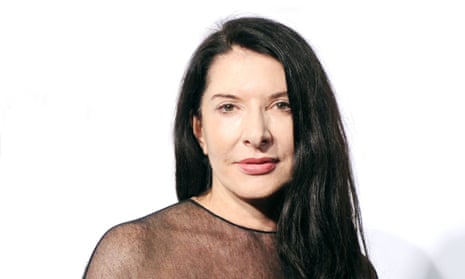Art star Marina Abramović and London’s Serpentine Gallery have become embroiled in a row over “nothing”.
A prestigious group of curators and art historians have written to the gallery questioning why Abramović’s latest performance piece - due to open 11 June and about which she has repeatedly emphasised the importance of “nothing” - fails to acknowledge the influence of another contemporary artist who has also made “nothing” central to her work.
“Nothing” is a project that Mary Ellen Carroll, a New York-based conceptual artist, has been working on since the 1990s. Carroll has been exhibited at the Whitney Museum in New York and the ICA in London and is the recipient of Guggenheim and Rockefeller fellowships. She also exhibited with Abramovic in a group show at the Smart Museum in Chicago in 2012.
The lack of recognition has worried a number of contemporary art experts, who have written to Serpentine curator Hans Ulrich Obrist asking him for clarification. Without acknowledgment, they fear Carroll’s work would be overshadowed by Abramović’s, and that Carroll would find it difficult to perform “Nothing” in future.
Among those who have been in touch with Obrist are art historian David Joselit, distinguished professor at City University of New York and former Carnegie professor of the history of art at Yale, Frazer Ward, professor at Smith College, an authority on performance art and author of No Innocent Bystanders: Performance Art and Audience, which discusses Abramović’s work, and Yona Backer, arts consultant to the Lambent Foundation and a former senior program officer at the Andy Warhol Foundation.
Speaking to The Guardian, Joselit said he had told Obrist he thought it was important for the gallery and Abramović to “acknowledge this genealogy”. He said the works were different but both addressed “The question of nothing. Doing nothing.”
Abramović’s piece - entitled 512 Hours - will involve the artist appearing in the Serpentine’s Hyde Park gallery from 10am to 6pm, six days a week, from 11 June to 25 August. It is billed as “a unique work created for the Serpentine”.
"It's the public and me and nothing else," she told The Guardian recently. "I took the objects away. But the encounter … I've never done anything as radical as this. This is as immaterial as you can go."
In an interview with the BBC, Abramović described the origin of the piece. "I called Hans Ulrich and I said, 'I don't know how you're going to take this, but this is what I want to do: nothing … there's nothing.' There's no work, just me, and the public is my live material, and that's the most radical, the most pure I can do."
“I wanted to prove that actually you can make art with nothing,” said Abramović.
Carroll, also known as MEC, has been performing variations of her “Nothing” since 1996. In a piece titled Nothing from 2006, Carroll writes, describing the intention of her work:
“Works where/when nothing happens. Images of nothing - is it the activity? Nothingness. Doing Nothing?
Hybrid-minimalism, do nothing - Don’t explain - Don’t modify behavior - Make a performance: nothing.”
In its most radical performance in 2006, Carroll left her apartment in New York with “nothing” except her passport and travelled to Argentina, living there for six weeks with nothing but the clothes she was wearing. Nothing is also documented in her book, MEC, published by art publisher Steidl in 2010, in the index cards that constitute much of her artwork and a video performance of a text about “Nothing” written by curator Anthony Elms.
“There are differences,” said Joselit. “I am not prepared to say Marina Abramović is involved in plagiarising or anything like that. Mary Ellen’s work, when she left for Argentina, is in many ways more extreme. I just think there should be a conversation,” he said.
Ward said he wouldn't expect Abramović to “reel off the history of nothing, but the gallery should be responsible about the claims they make”.
Obrist said he, fellow Serpentine curator Julia Peyton-Jones and their team thought that the best idea was to for the artists to have a conversation, which they have arranged.
He said “nothing” had long been a subject in art and pointed to John Cage’s 1952 silent music piece 4′33″ and Yves Klein's blank gallery walls in the 1950s. More recently, the legendary Gustav Metzger, who has had the idea of nothing in his work since the late 50s, co-curated a show called Voids at the Pompidou museum in Paris 2009, about more than five decades of “nothing”, and had a show in London in 2012 called Null Object: Gustav Metzger Thinks About Nothing.
Obrist said Abramovic’s piece was called 512 hours and the title refers to a Joseph Beuys piece, which he did for Documenta exhibition, lasting 100 days. Abramovic's work is very different from Mary Ellen Carroll's, he added.
“First of all Marina has never used the idea of nothing as her title,” he said. “ Many things will happen in the space. This piece evolves out of previous work that Marina has done. It will be very physical and interactive and performative.”
In an emailed statement, Abramović said: “There are no objects and no art works on the wall but there will be props like tables beds chairs and platforms etc and the public will be her living material which she is going to interact with 8 hours a day.”
Carroll was not immediately available for comment.
The Serpentine performance is Abramović’s first since her landmark show at the Museum of Modern Art in New York in 2010. That retrospective, entitled The Artist is Present, attracted record crowds and made an international celebrity of Abramović, who now counts Lady Gaga and James Franco among her admirers.

Comments (…)
Sign in or create your Guardian account to join the discussion